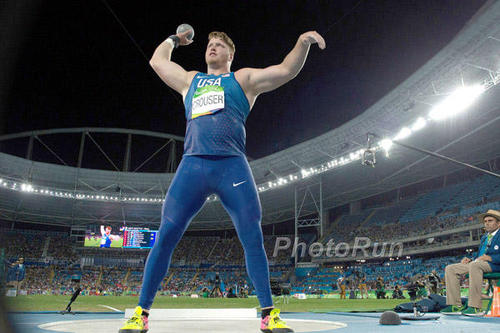 Ryan Crouser, photo by PhotoRun.net
Ryan Crouser, photo by PhotoRun.net
Ryan Crouser totally dominated the Rio Olympic shot put. Ryan Crouser totally dominated the U.S. Olympic Trials. Watching Ryan throw is quite exciting. This guy knows how to compete. Enjoy this fantastic feature by David Hunter on the 23 year old superstar. Just how good can Ryan Crouser be? Pretty exciting if you are a track and field fan!
Ryan Crouser: Is The Best Yet To Come?
Olympic Shot Put Gold Medalist Has Upside Potential
A favorite, accurate, and often-used sports saying declares, “Hard work beats talent when talent doesn’t work hard.” So true. Ah, but when talent does work hard you have, well, Ryan Crouser – a young, gifted, and dedicated athlete who is the reigning Olympic gold medalist and Olympic record-holder in the shot put.
Few look askance when – in the ensuing months that follow the Olympic Games – newly-crowned gold medalists take a break from training to rest, recuperate, and savor their winning performance. But when we recently caught up with Ryan Crouser, the 6’7″ 290 pound Olympic champion wasn’t chilling. He was logging time at the U.S. Olympic Training Center in Chula Vista, California working to build strength and gain some quality weight in preparation for the upcoming world championship year. “This year, I am planning to be probably about 305. So if I could get about 10 pounds of good, quality weight, I think that would be pretty good,” explains the Olympic champ in his quest to find his physique sweet spot – that body that provides the perfect combination of strength, speed, and agility. “I’ll probably go up to about 310 and then diet down to get to 305 just because for me especially, and for most throwers in general, when you lose a little weight you kind of gain a better feeling of athleticism and that helps make everything feel fresh and more athletic.”
As a member of Oregon’s legendary Crouser clan – where the throws are an integral part of the family heritage – track & field has simply been a part of Ryan’s DNA. His father Mitch was an ’84 Olympic Games alternate in the discus. Uncle Dean was a 3-time NCAA throws champion – 2 in the discus and 1 in the shot. Uncle Brian was a 2-time Olympian and 2-time NCAA champion in the javelin. More recently, cousin Sam – who throws the javelin – has been a 2-time NCAA champion and 2016 Olympian. And cousin Haley – also an accomplished javelin thrower – is the former American junior record holder in that event.
Supported but not pressured, Ryan charted his own sports pathway. “My family really supported me to do what I wanted in terms of athletics and just in general. So I wasn’t at all pushed into track & field,” he explains. “I played all the sports growing up. Track & field was the only sport you could do in middle school at first. I just went out and did that. When I first started I was doing everything – running, jumping, throwing.” But eventually that pathway led him off the track and into the throw circle. “With some natural talent and my Dad giving me some good solid guidance early on, I had a lot of success in the throws,” understates Crouser who at age 16 was the 2009 World Youth Championship gold medalist in the shot put and silver medalist in the discus. “So I decided to stick with that. By the time of my junior year, it was pretty apparent that I was going to stick with track.”
Accomplishing world class status as a teenage throws athlete didn’t prevent Ryan Crouser from performing well in the classroom. Upon his high school graduation, he was honored as the valedictorian of his class of 400. “I never got anything other than an A in high school,” admits Crouser who also garnered National Honor Society recognition by employing time-saving multi-tasking skills as a high schooler. “And in college I got even more efficient with my time,” he smiles. “I’ve gotten pretty good at it.”
When he wasn’t hitting the books or turning heads with his ever-improving throws, Crouser spent time as a prep attending to details and perfecting his craft in the ring. “I threw with the glide for a long time until my senior year in high school. I feel I got a lot of benefit for doing for it quite a while. I got the benefit of learning what really makes the glide effective. And I’ve tried to transfer that to the spin a little bit. I feel like I’ve had a different kind of benefit from throwing from the glide for as long as I did.” Is the spin the superior technique? “It’s tough to say definitely,” states Crouser who was the 2011 Track & Field News High School Athlete of the Year. “The spin gives you the opportunity to throw farther. But in terms of championships – even in recent years leading up to this year – most of the world championships and Olympics [shot titles] have been won with the glide.” But does the University of Texas graduate have any lingering apprehension about his switch from the glide to the spin? After a momentary pause to reflect on his 2016 season, Crouser doesn’t equivocate in his deadpan reply. “I’d say it’s worked out pretty well to this point.”
Breaking from family tradition, Crouser veered away from Eugene and headed off to Austin, Texas for college. “There was a little bit of pushback from the community, but not as much as I had expected,” reveals Crouser about his becoming a Longhorn, not a Duck. “Some diehard Oregon fans gave me a hard time, but nothing too negative. After my prep senior year and my freshman year in college, the folks in Eugene have definitely treated me like one of their own.”
While settling in at the University of Texas, the young shot putter began the transition to throwing a bigger, heavier implement. “Moving from the 12 pounds to the 16 pounds makes at least 10 feet of difference. And for me, it is even more of a difference just because I was lighter than and not as strong as the average college freshman. I was tall but not as heavy,” states Crouser who found the transition to be a lengthy one. But he remained patient and stayed after it. “It is tough transition from high school to your freshman year to go pick up and throw the 16 pound shot. To try to get ready to throw that 16 right away usually doesn’t work so well. We just went about it really gradually and planned out what we wanted to do. So it definitely was a long transition going from the 12 to the 16. I really couldn’t get completely comfortable with it until probably this year, until I could do the things that I wanted technically with the 16 pound without strength being a limiting factor. Once he figured it out, Crouser captured 4 NCAA shot put titles while at Texas.
After receiving his undergraduate diploma in 2015, Crouser entered U of T’s graduate school. Earning a Master’s degree in Finance normally takes two years. But Crouser had other plans. “This past year I finished my Masters [in Finance] in one year – from the fall of 2015 through May of 2016,” explains the multiple-time academic All-American, who admits the satisfaction associated with earning the advanced degree is almost matched by the liberating thrill of the additional time he has gained through the completion of his formal education.
“This past year it wasn’t possible to do all of the Diamond League competitions. So I just didn’t really have a sense of taking the Diamond League very seriously. Making the team at Trials was a main goal,” explains Crouser who nonetheless finished 4th in the season-long Diamond League shot put competition. The young athlete is excited about the prospects for 2017. “Next year will be different now that I am a full-time thrower and now that it is my job. And so I am looking to do some of the Diamond League and to hopefully win the Diamond League this year as I acknowledge that it is very important to compete for that. But my primary focus will be the world championships.”
A stickler for detail, Crouser also plans to address some of the finer aspects of the shot this coming year. “I don’t really feel like any one technical aspect is perfect at this point. I want to get a little bit stronger and a little bit heavier in terms of body weight. The other thing I am excited for this year is having the free time to do all of the little things right – so I can spend a lot more time working on flexibility and mobility. So I think that will make a pretty big difference. And then also in terms of technique, this coming year I will work on that. And this fall I have been working on the key aspects of my throw, just making it a little more fluid and maybe a little faster – just small stuff that you can only have happen over time, which you can’t really rush.”
The young Olympic champion acknowledges that world-class shot put athletes often don’t reach their physical peak until their later 20’s of even past their 30th birthday. “Yes, that is generally what you would expect.” And the thought of perhaps years of continued progression excites him. “At this point, I feel there is a lot that I have to work on. I have it in my mind to get stronger and then also improve some technical changes that I made after Rio and had some success with in Europe. Combining those two, the next thing I am looking forward to is possibly Randy Barnes’ world record at 23.12m / 75’10¼”.
The future looks bright for the young man who has delivered prodigious shot put results by combining terrific talent and an unshakable, focused work ethic. In 2016 – a year in which he completed a two year Master’s program in single year – the Oregon native nonetheless produced the two longest shot puts of the year – including the world-leading heave of 22.52m / 73’10¾”. That #1 ranked throw was the gold-medal winning put and also set the Olympic record. That winning mark at the Rio Games ties Crouser for 6th on the all-time U.S. performer list, ties him for 10th on the all-time world list, and makes him the youngest shot putter of all time to throw that far. And here’s the best news: All signs suggest that Ryan Crouser – at age 23 – has yet to give us his best shot.
Author

Dave Hunter is an award-winning journalist who is a U.S. Correspondent for Track & Field News. He also writes a weekly column and serves as Senior Writer for www.RunBlogRun.com, and covers championship track & field competition domestically and in such global capitals as Moscow, Birmingham, Zurich, Brussels, Beijing, Rio de Janeiro, Zagreb, Ostrava, and Doha. Hunter frequently serves as the arena or stadium announcer for championship track & field gatherings, including the Ivy League, the Big East, the Mid-American Conference, the NAIA, the Big Ten, and the Millrose Games. Hunter has undertaken foreign and domestic broadcast assignments. He ran his marathon P.R. 2:31:40 on the Boston Marathon course back in the Paleozoic Era. To find out more about Dave, visit his website: www.trackandfieldhunter.com He can be reached at: dave@trackandfieldhunter.com
View all posts




















